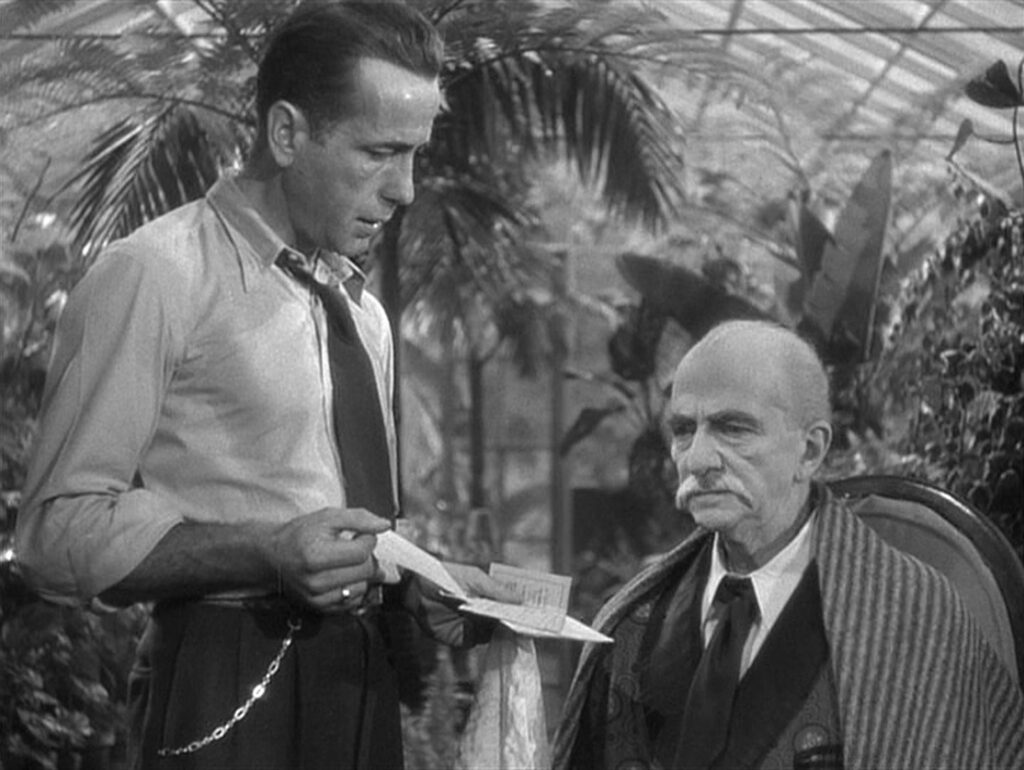
The Big Sleep
1946, directed by Howard Hawks
The Big Sleep is notorious for its complicated plot. Keeping track of all the characters, crimes, and motives so overtaxes most viewers’ attention that it’s easy to lose sight of the original mystery from back in General Sternwood’s greenhouse: What was Carmen being blackmailed for, and what happened to Sean Regan? The sheer number of plot components can make the movie look overstuffed, but the feeling of complication owes more to the script’s elegance. Everything is presented with the least possible explanation, so that the viewer can just barely piece together all the answers.
Why, for example, does Philip Marlowe pose as a homosexual when he first comes looking for Arthur Gwynn Geiger at the bookstore? There are two reasons. First, Agnes is tending the store, and because there’s a running joke that every woman except Vivian falls all over Marlowe at first sight, the movie needs a way to make an exception of Agnes… otherwise he wouldn’t get very far in confirming that the bookstore is a front for crime. Second, assuming Marlowe has done a bit of research on Geiger, his pose contributes to the insinuation that Geiger himself is gay (an understanding made explicit in the novel, but barred from Hollywood movies by the Hays Code) which will later give Carol Lundgren, apparently Geiger’s lover, his motive for killing Joe Brody.
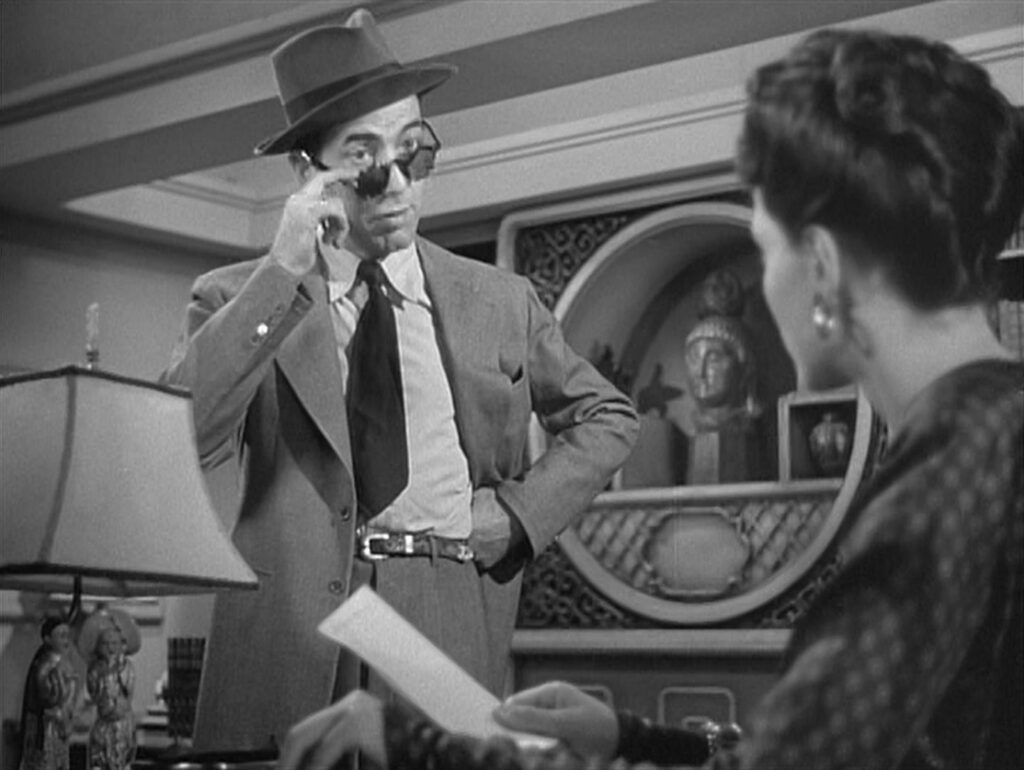
Another of the many questions that might rush through the viewer’s mind is why Carol Lundgren should arrive at the mistaken belief that Brody killed Geiger. After all, that very afternoon Lundgren had helped Brody pack up the bookstore’s inventory. It all fits together only when we stand back and realize that Brody and Lundgren aren’t close; Brody is an independent grifter parasiting off the schemes of Geiger and Eddie Mars, and he’s connected to the bookshop through his girlfriend Agnes. Lundgren likely remembered Brody’s car parked outside Geiger’s house the night he was shot, but he never guessed that Brody was merely after the incriminating photo snatched by Geiger’s real killer, Owen Taylor.
Then there’s the famous question of who killed Owen Taylor. It’s famous because of the oft-repeated story that even novelist Raymond Chandler couldn’t answer it when Howard Hawks and some of the cast asked for clarification. The movie never says so explicitly, but when Brody keeps lying and changing his answers under pressure from Marlowe, there’s more than enough to insinuate that Brody did it.
These examples give us a picture of how thoroughly thought through The Big Sleep‘s script is. Far from being a pulp mystery hiding its plot holes behind a barrage of action, it’s a carefully crafted story worthy of its Nobel laureate screenwriter William Faulkner. Each detail carries its weight. Putting aside the numerous questions that arise, the story itself is surprisingly manageable if we find the structure in it. Inside the labyrinthine plot is a simple skeleton, and if we take an x-ray to it we’ll find what had seemed impossible – that it’s not so difficult to follow and even to memorize.
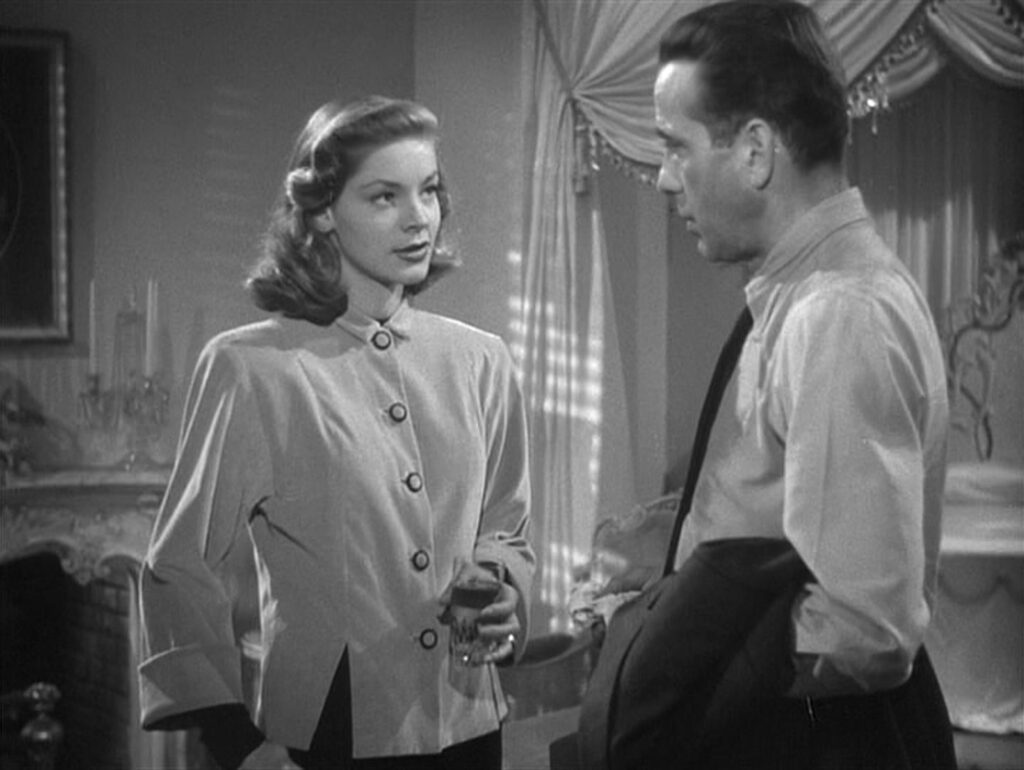
“Big sleep” is a euphemism for death, and death, as it turns out, is the key to this skeleton. Sean Regan’s death is the starting point, but it’s in the past, outside the story’s frame. The six additional deaths within the movie’s timeline supply the hidden structure that binds and supports the hyper-intricate plot:
1. Arthur Gwynn Geiger is killed by Owen Taylor;
2. Owen Taylor is killed by Joe Brody;
3. Joe Brody is killed by Carol Lundgren, who is then arrested.
At this point the action pauses to develop Philip Marlowe’s romance with Vivian Sternwood in the restaurant and casino scenes. In the second half the killings resume:
4. Harry Jones is killed by Lash Canino;
5. Lash Canino is killed by Philip Marlowe
6. Eddie Mars is killed by his own men.
Splitting the deaths into two groups of three exposes an unexpected symmetry. With one key exception, whoever kills someone is the next to be killed until justice intervenes to break the cycle. We can be sure the writers took care to preserve this symmetry because, for one thing, they go out of their way to make sure there are only six deaths: if Art Huck didn’t chicken out at Marlowe’s warning shots in Realito, there would be an odd seventh.
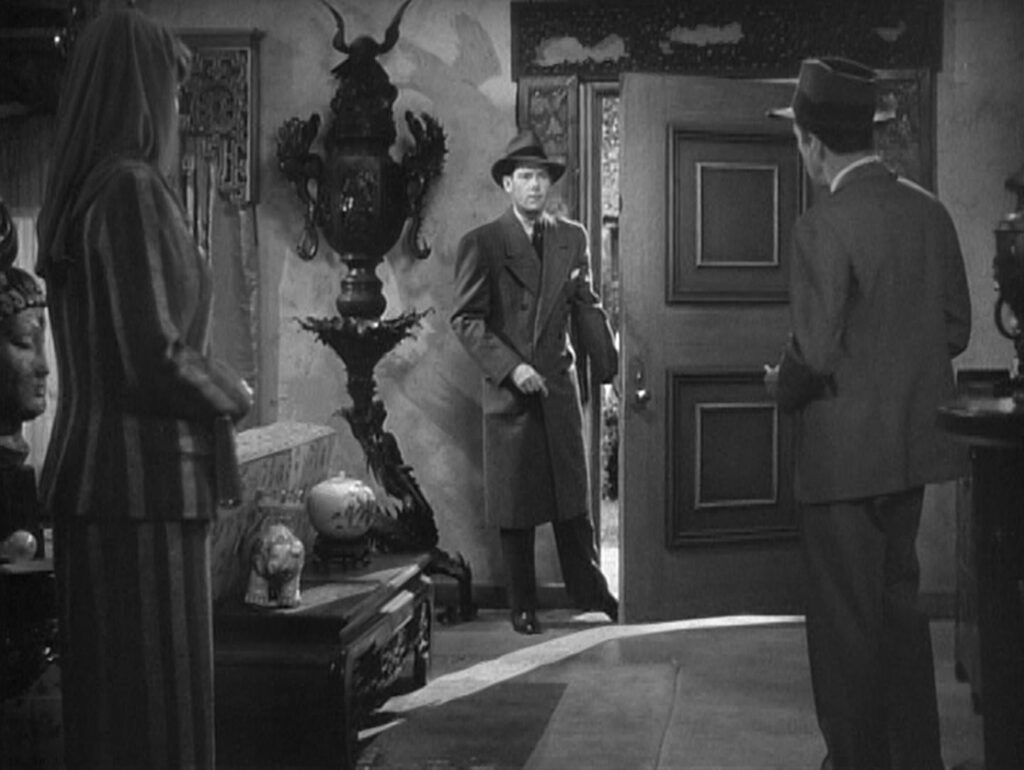
The exception is Eddie Mars’ death at the end, which serves a dual purpose. First of all it heightens the tension at the climax. Marlowe was the last to kill someone, so we have good reason to fear that he will be killed next. Instead he turns the tables on Mars, reversing the pattern and escaping his apparent fate. Secondly, this twist defines what sets Marlowe apart from every other character – his brains. It would be hard to overstate how clever his trick is. Having virtually written his own death sentence, he confronts his nemesis Eddie Mars directly, but he cannot kill the man in cold blood. Mars doesn’t carry a gun or do his own killing, and Marlowe isn’t a criminal. On the other hand, he’d have slim chances in a battle against all of Mars’ hired men. First he tricks Mars into setting up an ambush at Geiger’s house, and when Marlowe surprises Mars by being there already, he has already calculated that if the hired men outside hear gunshots inside, they will expect Marlowe to come out first. Once they’ve killed their own boss, Marlowe is relatively safe inside the house because no one will pay them to kill him. Outside he’s a threat, and we’ve already seen what they’d do to him.
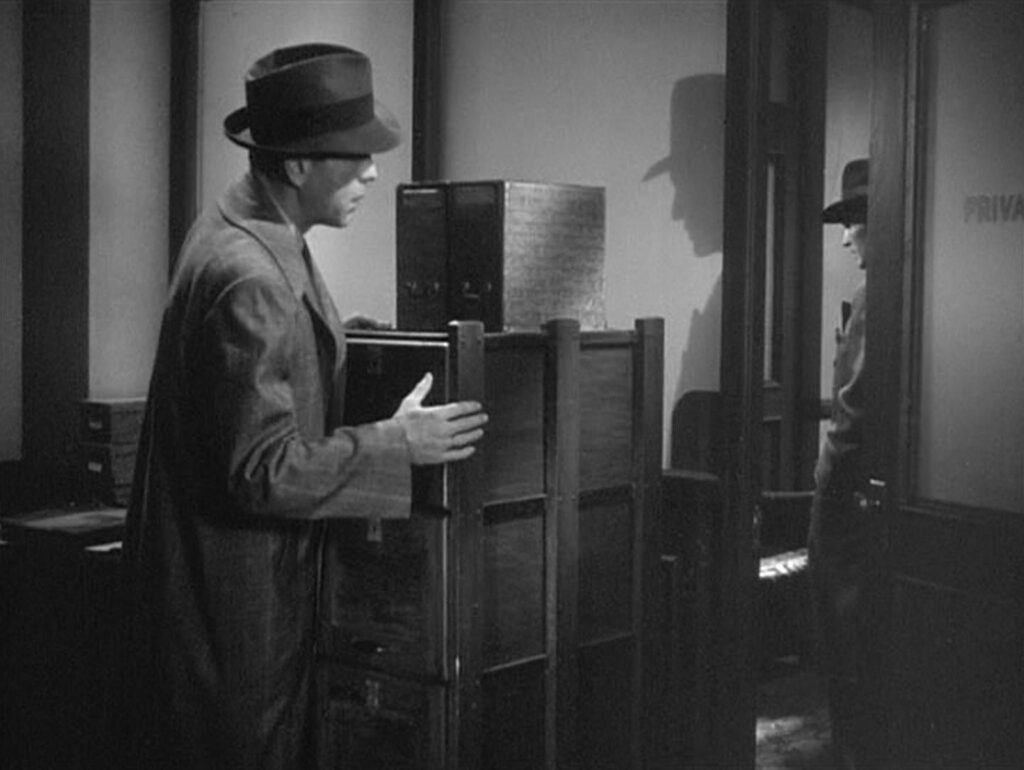
Marlowe wins because he’s cleverer than his enemies, but his cleverness goes hand in hand with a love for knowledge that sets him apart from every other character. In the opening scene he asks General Sternwood, “You want me to take this Geiger fellow off your back, is that right? Want to know anything?” The general answers, “I just want to get rid of him.” Marlowe, however, wants to know… badly enough to keep investigating after he’s been paid off. In fact he pays Agnes 40% of his earnings to learn where Eddie Mars’ wife is hiding out. No one else is driven by such a need to know. Vivian’s uppermost wish is to protect her sister, and later to protect Marlowe by keeping him off the case. The gangsters are motivated by money or power, Harry Jones by his love for Agnes, Carol Lundgren by revenge. Even Inspector Ohls cares more about keeping order than knowing the truth.
Looking at Marlowe in this context, it’s significant that he begins his interview with the general by saying he went to college. In the 1940s that would have put him in an elite minority, and by making Humphrey Bogart an intellectual the movie casts him against type. His first stop after the Sternwood mansion is the library, where the librarian tells him “You don’t look like a man who’d be interested in first editions.” After the library he visits two bookstores before the action begins (in Chandler’s novel Geiger sells pornography, so the movie pushes things in a more erudite direction). Marlowe never puts on airs, but when Vivian assumes he’s never heard of Marcel Proust he responds by inviting her into his “boudoir”, hinting that he’s more savvy than she thinks he is.
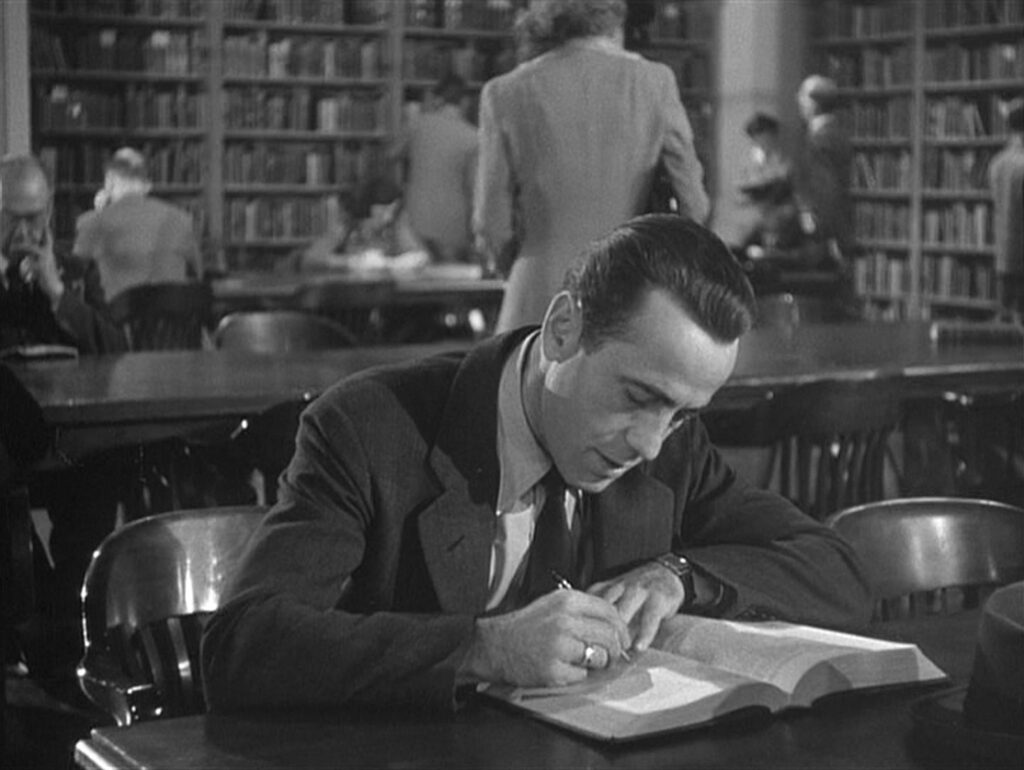
Hollywood had good reason to popularize thinking, both during the war when The Big Sleep was made and after the war when it was fixed up and released. The United States has a long history of anti-intellectualism, but its military needed smart soldiers, and its economy needed an educated workforce. Movie detectives were always models of cleverness, but Philip Marlowe took cleverness a few levels higher. More important than his innate talents, however, is his deep-seated love for truth. Halfway through the story he could have wrapped up his work, won Vivian, and felt he had contributed to justice, but his irrepressible need to understand things drives him to greatness.
CONNECTIONS:
The Sea Wolf – Complicated climax where a character calculates exactly what the villain will think and do
Holiday Inn – Definition of courage made during the war vs. celebration of intellect made at end of war
Born Yesterday – Argument for the importance of thinking as a bulwark against corruption
Death of a Cyclist – Each major character has a different relationship to the truth
The Quiller Memorandum – Investigator who is a model of cleverness; script by a Nobel laureate
Chinatown – L.A. private eye who keeps pursuing a case after fulfilling his bargain, in spite of threats and violence; daughter of wealthy old man who loves the detective but whose protective concern for her sister makes her suspicious; detective confronts villain at end by luring him to a house he’s visited a few times before; female lead wears a lace veil over her face (in the first cut of The Big Sleep); complicated web of inscrutable motives